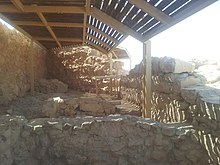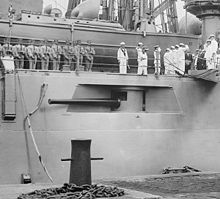Casemate
In its original early modern meaning, the term referred to a vaulted chamber in a fort, which may have been used for storage, accommodation, or artillery which could fire through an opening or embrasure.Although the outward faces of brick or masonry casemates proved vulnerable to advances in artillery performance, the invention of reinforced concrete allowed newer designs to be produced well into the 20th century.With the introduction of ironclad warships, the definition was widened to include a protected space for guns in a ship, either within the hull or in the lower part of the superstructure.[5] Originally thought to have been introduced to the region by the Hittites, this has been disproved by the discovery of examples predating their arrival, the earliest being at Ti'inik (Taanach) where such a wall has been dated to the 16th century BC.[12] In the late 18th century, Marc René, marquis de Montalembert (1714–1800) experimented with improved casemates for artillery, with ventilation systems that overcame the problem of smoke dispersal found in earlier works.[15][16] In the early 19th century, French military engineer Baron Haxo designed a free-standing casemate that could be built on the top of the rampart, to protect guns and gunners from the high-angle fire of mortars and howitzers.[18] In the early 1860s, the British, apprehensive about a possible French invasion, fortified the naval dockyards of southern England with curved batteries of large guns in casemates, fitted with laminated iron shields tested to withstand the latest projectiles.[19] However, in the American Civil War (1861–1865), the exposed masonry of casemate batteries was found to be vulnerable to modern rifled artillery; Fort Pulaski was breached in a few hours by only ten such guns.These works, the first of which was Fort de Mutzig near Strasbourg, had separate artillery blocks, infantry positions and underground barracks, all built of reinforced concrete and connected by tunnels or entrenchments.[23] Following experience gained in the World War I, French engineers began to design a new scheme of fortifications to protect their eastern border, which became known as the Maginot Line.[26] In warship design the term "casemate" has been used in a number of ways, but it generally refers to a protected space for guns within a ship's hull or superstructure.Although both sides of the Civil War used casemate ironclads, the ship is mostly associated with the southern Confederacy, as the north also employed turreted monitors, which the south was unable to produce.The saved weight can be used to mount a heavier, more powerful gun or alternatively increase the vehicle's armor protection in comparison to regular, turreted tanks.During World War II, casemate-type armored fighting vehicles were heavily used by both the combined German Wehrmacht forces, and the Soviet Red Army.














Casemate PublishersFort Knox, Mainefortificationwarshiparmoured fighting vehicleantiquitybattering ramsembrasurereinforced concreteironcladsuperstructuregun turretsarmored fighting vehiclesslaughterhouseMasadaIsraelNear EastHittitesTi'inik16th century BC9th century BCNeo-Assyrian Empirerampartbastion fortsbastionsFort Point, San FranciscoMarc René, marquis de Montalembertcoastal fortificationsÎle-d'AixRochefort, Charente-MaritimeAnglo-French WarCherbourgJonathan WilliamsThird SystemsCastle WilliamsNew York HarborBaron HaxomortarshowitzersFort BovisandPlymouthCrimean WarRoyal NavyKronstadtSevastopolMalakoff Towerapprehensive about a possible French invasionAmerican Civil Warrifled artilleryFort Pulaskibarbettesdisappearing carriagesSéré de Rivières systemhigh explosiveFort d'UxegneyVosges departmentImperial GermanyFort de MutzigStrasbourgfield guns15 cm naval gunLongues-sur-Mer batteryWorld War IMaginot Lineanti-tank gunsWorld War IIOrganisation TodtAtlantic Wallspigot mortarsrocket-assisted projectilesrecoilless riflesdemolition chargeearthquake bombsFrench ironclad GloiresmoothboreHMS Warrior (1860)casemate ironcladsfreeboardConfederacymonitorsHampton RoadsUSS MonitorCSS VirginiaUSS Merrimackcentral battery shipbelt armourHMS AlexandraUSS North DakotaRoyal Sovereign classHMS ResistanceEdgar classBlake classpre-dreadnoughtIron Duke-class dreadnoughtsJapanese battleship HarunaHMS DreadnoughtInvincibletorpedodestroyersAttack on Pearl HarborHMS WarspiteOmaha-classHSwMS GotlandJagdtigerStrv 103WehrmachtRed Armytank destroyersassault gunsPanzerjägerElefantJagdpanzerJagdpanzer IVJagdpantherSturmgeschütz IIISturmgeschütz IVSamokhodnaya UstanovkaSU-100ISU-152Tortoisemain battle tanksKanonenjagdpanzerSwedish ArmyStridsvagn 103Versuchsträger 1–2Bunker